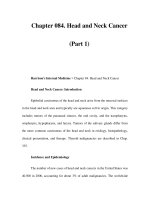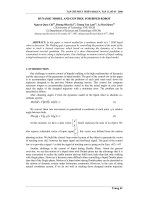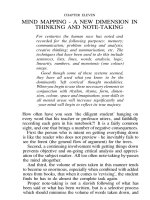Physics, Pharmacology and Physiology for Anaesthetists - 1 pps
Bạn đang xem bản rút gọn của tài liệu. Xem và tải ngay bản đầy đủ của tài liệu tại đây (332.77 KB, 26 trang )
Physics, Pharmacology and Physiology for Anaesthetists
Key concepts for the FRCA
Physics, Pharmacology and
Physiology for Anaesthetists
Key concepts for the FRCA
Matthew E. Cross MB ChB MRCP FRCA
Specialist Registrar in Anaesthetics, Queen Alexandra Hospital, Portsmouth, UK
Emma V. E. Plunkett MBBS MA MRCP FRCA
Specialist Registrar in Anaesthetics, St Mary’s Hospital, London, UK
Foreword by
Tom E. Peck MBBS BSc FRCA
Consultant Anaesthetist, Royal Hampshire County Hospital, Winchester, UK
CAMBRIDGE UNIVERSITY PRESS
Cambridge, New York, Melbourne, Madrid, Cape Town, Singapore, São Paulo
Cambridge University Press
The Edinburgh Building, Cambridge CB2 8RU, UK
First published in print format
ISBN-13 978-0-521-70044-3
ISBN-13 978-0-511-38857-6
© M. Cross and E. Plunkett 2008
Every effort has been made in preparing this publication to provide accurate and up-to-
date information which is in accord with accepted standards and practice at the time of
publication. Although case histories are drawn from actual cases, every effort has been
made to disguise the identities of the individuals involved. Nevertheless, the authors,
editors and publishers can make no warranties that the information contained herein is
totally free from error, not least because clinical standards are constantly changing through
research and regulation. The authors, editors and publishers therefore disclaim all liability
for direct or consequential damages resulting from the use of material contained in this
publication. Readers are strongly advised to pay careful attention to information provided
by the manufacturer of any drugs or equipment that they plan to use.
2008
Information on this title: www.cambridge.org/9780521700443
This publication is in copyright. Subject to statutory exception and to the provision of
relevant collective licensing agreements, no reproduction of any part may take place
without the written
p
ermission of Cambrid
g
e University Press.
Cambridge University Press has no responsibility for the persistence or accuracy of urls
for external or third-party internet websites referred to in this publication, and does not
g
uarantee that any content on such websites is, or will remain, accurate or a
pp
ro
p
riate.
Published in the United States of America by Cambridge University Press, New York
www.cambridge.org
eBook (NetLibrary)
paperback
To Anna and Harvey for putting up with it all
and for Dad
MC
For all my family
but especially for Adrian
EP
Contents
Acknowledgements page x
Preface xi
Foreword
Tom E. Peck xiii
Introduction 1
Section 1
*
Mathematical principles 5
Mathematical relationships 5
Exponential relationships and logarithms 7
Physical measurement and calibration 14
The SI units 18
Section 2
*
Physical principles 21
Simple mechanics 21
The gas laws 24
Laminar flow 26
Turbulent flow 27
Bernoulli, Venturi and Coanda 28
Heat and temperature 30
Humidity 33
Latent heat 35
Isotherms 37
Solubility and diffusion 38
Osmosis and colligative properties 40
Resistors and resistance 42
Capacitors and capacitance 43
Inductors and inductance 46
Defibrillators 48
Resonance and damping 50
Pulse oximetry 54
Capnography 57
Absorption of carbon dioxide 62
Cardiac output measurement 64
The Doppler effect 68
Neuromuscular blockade monitoring 69
Surgical diathermy 74
Cleaning, disinfection and sterilization 76
Section 3
*
Pharmacological principles 78
The Meyer–Overton hypothesis 78
The concentration and second gas effects 80
Isomerism 82
Enzyme kinetics 85
Drug interactions 88
Adverse drug reactions 89
Section 4
*
Pharmacodynamics 91
Drug–receptor interaction 91
Affinity, efficacy and potency 93
Agonism and antagonism 97
Hysteresis 103
Section 5
*
Pharmacokinetics 104
Bioavailability 104
Volume of distribution 105
Clearance 107
Compartmental models 109
Context-sensitive half time 113
Section 6
*
Respiratory physiology 115
Lung volumes 115
Spirometry 117
Flow–volume loops 119
The alveolar gas equation 123
The shunt equation 124
Pulmonary vascular resistance 126
Ventilation/perfusion mismatch 127
Dead space 128
Fowler’s method 129
The Bohr equation 130
Oxygen delivery and transport 132
The oxyhaemoglobin dissociation curve 134
Carriage of carbon dioxide 136
Work of breathing 138
Control and effects of ventilation 139
Compliance and resistance 142
viii Contents
Section 7
*
Cardiovascular physiology 144
Cardiac action potentials 144
The cardiac cycle 146
Pressure and flow calculations 149
Central venous pressure 151
Pulmonary arterial wedge pressure 153
The Frank–Starling relationship 155
Venous return and capillary dynamics 157
Ventricular pressure–volume relationship 162
Systemic and pulmonary vascular resistance 167
The Valsalva manoeuvre 169
Control of heart rate 171
Section 8
*
Renal physiology 173
Acid–base balance 173
Glomerular filtration rate 176
Autoregulation and renal vascular resistance 177
The loop of Henle 179
Glucose handling 181
Sodium handling 182
Potassium handling 183
Section 9
*
Neurophysiology 184
Action potentials 184
Muscle structure and function 188
Muscle reflexes 191
The Monro–Kelly doctrine 193
Intracranial pressure relationships 194
Formation and circulation of cerebrospinal fluid 197
Pain 198
Section 10
*
Statistical principles 200
Data types 200
Indices of central tendency and variability 202
Types of distribution 206
Methods of data analysis 208
Error and outc ome prediction 217
Clinical trials 219
Evidence-based medicine 220
Appendix 222
Index 236
Contents ix
Acknowledgements
We are grateful to the following individuals for their invaluable help in bringing
this book to publication
Dr Tom Peck MBBS BSc FRCA
Anaesthetics Department, Royal Hampshire County Hospital, Winchester, UK
Dr David Smith DM FRCA
Shackleton Department of Anaesthetics, Southampton General Hospital,
Southampton, UK
Dr Tom Pierce MRCP FRCA
Shackleton Department of Anaesthetics, Southampton General Hospital,
Southampton, UK
Dr Mark du Boulay BSc FRCA
Anaesthetics Department, Royal Hampshire County Hospital, Winchester, UK
Dr Roger Sharpe BSc FRCA
Anaesthetics Department, Northwick Park Hospital, London, UK
In addition we are grateful for permission to reprint the illustrations on pages 183
and 184 from International Thomson Publishing Servi ces Ltd.
Cheriton House, North Way, Andover, UK
Preface
The examinations in anaesthesia are much feared and respected. Although fair,
they do require a grasp of many subjects which the candidate may not have been
familiar with for some time. This is particularly true with regards to the basic
science components.
This book does not aim to be an all-inclusive text, rather a companion to other
books you will already have in your collection. It aims to allow you to have an
additional reference point when revising some of these difficult topics. It will
enable you to quickly and easily bring to hand the key illustrations, definitions or
derivations that are fundamental to the und erstanding of a particular subject. In
addition to succinct and accurate definitions of key phrases, important equations
are derived step by step to aid understanding and there are more than 180
diagrams with explanations throughout the book.
You should certainly find a well-trusted textbook of anaesthesia if you wish to
delve deeper into the subject matter, but we hope to be able to give you the
knowledge and reasoning to tackle basic science MCQs and, more crucially, to
buy you those first few lines of confident response when faced with a tricky basic
science viva.
Good luck in the examinations, by the time you read this the end is already in
sight!
Foreword
Many things are currently in a state of flux within the world of medical education
and training, and the way in which candidates approach examinations is no
exception. Gone are the days when large w eighty works are the first port of call
from which to start the learning experience. Trainees know that there are more
efficient ways to get their heads around the concepts that are required in order to
make sense of the facts.
It is said that a picture says a thousand words and this extends to diagrams as
well. However, diagrams can be a double-edged sword for trainees unless they are
accompanied by the relevant level of detail. Failure to label the axis, or to get the
scale so wrong that the curve becomes contradictory is at best confusing.
This book will give back the edge to the examination candidate if they digest its
contents. It is crammed full of precise, clear and well-labelled diagrams. In
addition, the explanations are well structured and leave the reader with a clear
understanding of the main point of the diagram and any additional information
where required. It is also crammed full of definitions and derivations that are very
accessible.
It has been pitched at those studying for the primary FRCA examination and I
have no doubt that they will find it a useful resource. Due to its size, it is never
going to have the last word, but it is not trying to achieve that. I am sure that it will
also be a useful resource for those preparing for the final FRCA and also for those
preparing teaching material for these groups.
Doctors Cross and Plunkett are to be congratulated on preparing such a clear
and useful book – I shall be recommending it to others.
Dr Tom E. Peck MBBS BSc FRCA
Consultant Anaesthetist, Royal Hampshire County Hospital, Winchester, UK
Introduction
This book is aimed primarily at providing a reference point for the common
graphs, definitions and equations that are part of the FRCA syllabus. In certain
situations, for example the viva sections of the examinations, a clear structure to
your answer will help you to appear more confident and ordered in your response.
To enable you to do this, you should have a list of rules to hand which you can
apply to any situation.
Graphs
Any graph should be constructed in a logical fashion. Often it is the best-known
curves that candidates draw most poorly in their rush to put the relationship
down on paper. The oxyhaemoglobin dissociation curve is a good example. In
the rush to prove what they know about the subject as a whole, candidates
often supply a poorly thought out sigmoid-type curve that passes through none
of the traditional reference points when considered in more detail. Such an
approach will not impress the examiner, despite a sound knowledge of the
topic as a whole. Remembering the following order may help you to get off to a
better start.
Size
It is important to draw a large diagram to avoid getting it cluttered. There will
always be plenty of paper supplied so don’t be afraid to use it all. It will make the
examiner’s job that much easier as well as yours.
Axes
Draw straight, perpen dicular axes and label them with the nam e of the variable
and its units before doing anything else. If common values are known for the
particular variable then mark on a sensible range, for example 0–300 mmHg
for blood pressure. Remember that logarithmic scales do not extend to zero as
zero is an impossible result of a logarithmic function. In addition, if there are
important reference points they should be marked both on the axis and where
two variables intersect on the plot area, for example 75% saturation corres-
ponding to 5.3 kPa for the venous point on the oxyhaemoglobin dissociation
curve. Do all of this before considering a curve and do not be afraid to talk out
loud as you do so – it avoids uncomfortable silences, focuses your thoughts and
shows logic.
Beginning of a curve
Consider where a curve actually starts on the graph you are drawing. Does it
begin at the origin or does it cross the y axis at some other point? If so, is there
a specific value at whi ch it crosses the y axis and why is that the case? Some
curves do not come into contact with either axis, for example exponentials
and some physiological autoregulation curves. If this is the case, then you should
demonstrate this fact and be ready to explain why it is so. Consider what
happens to the slope of a curve at its extremes. It is not uncommon for a
curve to flatten out at high or low values, and you should indicate this if it is
the case.
Middle section
The middle section of a curve may cross some important points as previously
marked on the graph. Make sure that the curve does, in fact, cross these points
rather than just come close to them or you lose the purpose of marking them on in
the first place. Always try to think what the relationship between the two variables
is. Is it a straight line, an exponential or otherwise and is your curve representing
this accurately?
End of a curve
If the end of a curve crosses one of the axes then draw this on as accurately as
possible. If it does not reach an axis then say so and consider what the curve will
look like at this extreme.
Other points
Avoid the temptation to overly annotate your graphs but do mark on any
important points or regions, for example segments representing zero and first-
order kinetics on the Michaelis–Menten graph.
Definitions
When giving a definition, the aim is to accurately describe the principle in
question in as few a words as possible. The neatness with which your definition
appears will affect how well considered your answer as a whole comes across.
Definitions may or may not include units.
Definitions containing units
Always think about what units, if any, are associated with the item you are trying
to describe. For example, you know that the units for clearance are ml.min
À1
and
so your definition must include a statement about both volume (ml) and time
2 Introduction
(min). When you are clear about what you are describing, it should be presented
as succinctly as possible in a format such as
‘x’ is the volume of plasma
‘y’ is the pressure found when
‘z’ is the time taken for
Clearance (ml.min
À1
) is the volume (ml) of plasma from which a drug is
completely removed per unit time (min)
Pressure (N.m
À2
) describes the result of a force (N) being applied over a given
area (m
2
).
You can always finish your definition by offering the units to the examiner if you
are sure of them.
Definitions without units
If there are no units involved , think about what process you are being asked to
define. It may be a ratio, an effect, a phenomenon, etc.
Reynold’s number is a dimensionless number
The blood:gas partition coefficient is the ratio of
The second gas effect is the phenomenon by which
Conditions
Think about any conditions that must apply. Are the measurements taken at
standard temperature and pressure (STP) or at the prevailing temperature and
pressure?
The triple point of water is the temperature at which all three phases are in
equilibrium at 611.73 Pa. It occurs at 0.01 8C.
There is no need to mention a condition if it does not affect the calculati on. For
example, there is no need to mention ambient pressure when defining saturated
vapour pressure (SVP) as only temperature will alter the SVP of a volatile.
Those definitions with clearly associated units will need to be given in a clear
and specific way; those without units can often be ‘padded’ a little if you are not
entirely sure.
Equations
Most equations need only be learned well enough to understand the components
which make up the formula such as in
V ¼ IR
where V is voltage, I is current and R is resistance.
Introduction 3
There are, however, some equations that deserve a greater understanding of their
derivation. These include,
The Bohr equation
The Shunt equation
The Henderson–Hasselbach equation
These equations are fully derived in this book with step by step explanations of the
mathematics involved. It is unlikely that the result of your examination will hinge
on whether or not you can successfully derive these equations from first princi-
ples, but a knowledge of how to do it will make things clearer in your own mind.
If you are asked to derive an equation, remember four things.
1. Don’t panic!
2. Write the end equation down first so that the examiners know you
know it.
3. State the first principles, for example the Bohr equation considers a
single tidal exhalation comprising both dead space and alveolar gas.
4. Attempt to derive the equation.
If you find yourself going blank or taking a wrong turn midway through then do
not be afraid to tell the examiners that you cannot remember and would they
mind moving on. No one will mark you down for this as you have already
supplied them with the equation and the viva will move on in a different direction.
4 Introduction
Section 1
*
Mathematical principles
Mathematical relationsh ips
Mathematical relationships tend not to be tested as stand-alone topics but an
understanding of them will enable you to answer other topics with more authority.
Linear relationships
y ¼ x
x
y
Draw and label the axes as shown. Plot the line so that it passes through the
origin (the point at which both x and y are zero) and the value of y is equal to
the value of x at every point. The slope when drawn correctly should be at 458
if the scales on both axes are the same.
y ¼ ax þ b
x
y
b
Slope
= a
This line should cross the y axis at a value of b because when x is 0, y must be
0 þb. The slope of the graph is given by the multiplier a. For example, when the
equation states that y =2x,theny will be 4 when x is 2, and 8 when x is 4, etc. The
slope of the line will, therefore, be twice as steep as that of the line given by y=1x.
Hyperbolic relationships (y = k/x)
x
y
This curve describes any inverse relationship. The commonest value for the
constant, k, in anaesthetics is 1, which gives rise to a curve known as a
rectangular hyperbo la. The line never crosses the x or the y axis and is
described as asymptotic to them (see definition below). Boyle’s law is a good
example (volume = 1/pressure). This curve looks very similar to an exponen-
tial decline but they are entirely different in mathematical terms so be sure
about which one you are describing.
Asymptote
A curve that continually approaches a given line but does not meet it at any
distance.
Parabolic relationships (y = kx
2
)
x
y
k
= 2
k
= 1
These curves describe the relationship y = x
2
and so there can be no negative
value for y. The value for ‘k’ alters the slope of the curve, as ‘a’ does for the
equation y = ax þb. The curve crosses the y axis at zero unless the equation is
written y = kx
2
þb, in which case it crosses at the value of ‘b’.
6 Section 1
Á
Mathematical principles
Exponential relationships and log arithms
Exponential
A condition where the rate of change of a variable at any point in time is
proportional to the value of the variable at that time.
or
A function whereby the x variable becomes the exponent of the equation
y =e
x
.
We are normally used to x being represented in equations as the base unit (i.e.
y = x
2
). In the exponential function, it becomes the exponent (y =e
x
), which
conveys some very particular properties.
Euler’s number
Represents the numerical value 2.71828 and is the base of natural logarithms.
Represented by the symbol ‘e’.
Logarithms
The power (x) to which a base must be raised in order to produce the number
given as for the equation x = log
base
(number).
The base can be any number, common numbers are 10, 2 and e (2.71828).
Log
10
(100) is, therefore, the power to which 10 must be raised to produce the
number 100; for 10
2
= 100, therefore, the answer is x = 2. Log
10
is usually written
as log whereas log
e
is usually written ln.
Rules of logarithms
Multiplication becomes addition
logðxyÞ¼logðxÞþlogðyÞ
Division becomes subtraction
logðx=yÞ¼logðxÞÀlogðyÞ
Reciprocal becomes negative
logð1=xÞ¼ÀlogðxÞ
Power becomes multiplication
logðx
n
Þ¼n: logðxÞ
Any log of its own base is one
log
10
ð10Þ¼1 and lnðeÞ¼1
Any log of 1 is zero because n
0
always equals 1
log
10
ð1Þ¼0 and lnð1Þ¼0
Basic positive exponential (y =e
x
)
x
1
y
The curve is asymptotic to the x axis. At negative values of x,theslopeisshallow
but the gradient increases sharply when x is positive. The curve intercepts the
y axis at 1 because any number to the power 0 (as in e
0
)equals1.Most
importantly, the value of y at any point equals the slope of the graph at that
point.
Clinical tear away positive exponential (y = a.e
kt
)
a
Time (t
)
y
The curve crosses y axis at value of a. It tends towards infinity as value of t
increases. Thi s is clearly not a s ustainable physiological proc ess bu t could be seen
in the early stages of bacterial replication where y equals nu mber of bacteria.
8 Section 1
Á
Mathematical principles
Basic negative exponential (y = a
Àx
)
x
y
1
The x axis is again an asymptote and the line crosses the y axis at 1. This time
the curve climbs to infinity as x becomes more negative. This is because Àx is
now becoming more positive. The curve is simply a mirror image, around the
y axis, of the positive exponent ial curve seen above.
Physiological negative exponential (y = a.e
Àkt
)
Time (t )
y
a
The curve crosses the y axis at a value of a.Itdeclinesexponentiallyast increases.
The line is asymptotic to the x axis. This curve is seen in physiological processes
such as drug elimination and lung volume during passive expiration.
Physiological build-up negative expon ential (y = aÀb.e
Àkt
)
Time (t )
Asymptote
y
a
Exponential relationships and logarithms 9
The curve passes through the origin and has an asymptote that crosses the y
axis at a value of a. Although y increases with time, the curve is actually a
negative exponential. This is because the rate of increase in y is decreasing
exponentially as t increases. This curve may be seen clinically as a wash-in
curve or that of lung volume during positive pressure ventilation using
pressure-controlled ventilation.
Half life
The time taken for the value of an exponential function to decrease by half is
the half life and is represented by the symbol t
1/2
or
the time equivalent of 0.693tt= time constant
An exp onential process is said to be complete after five half lives. At this point,
96.875% of the process has occurred.
Graphical representation of half life
Time (t )
Percentage of initial
value (y )
t
½
t
½
25
50
100
This curve needs to be drawn accurately in order to demonstrate the principle.
After drawi ng and labelling the axes, mark the key values on the y axis as
shown. Your curve must pass through each value at an equal time interval on
the x axis. To ensure this, plot equal time periods on the x axis as shown, before
drawing the curve. Join the points with a smooth curve that is asymptotic to
the x axis. This will enable you to describe the nature of an exponential decline
accurately as well as to demonstrate easily the meaning of half life.
10 Section 1
Á
Mathematical principles









